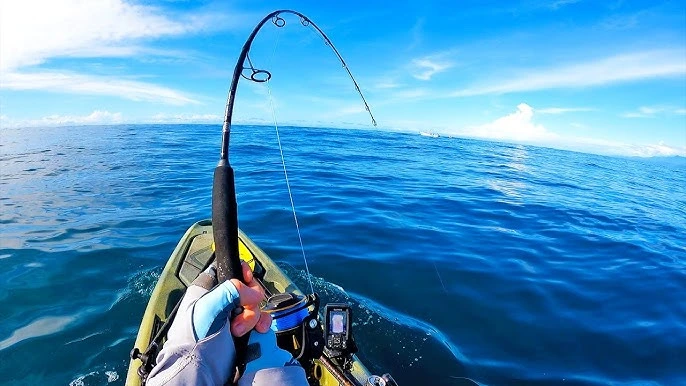Deep Sea Fishing: Tips, Techniques, and Locations
Deep-sea fishing is an exhilarating and challenging sport that allows anglers to explore the vast expanses of the ocean in search of trophy-worthy catches.
Whether you are a beginner looking to dip your toes into this thrilling adventure or a seasoned veteran seeking to enhance your skills, this ultimate guide will provide you with invaluable information, tips, and techniques to make the most of your deep-sea fishing experience.
Additionally, we will explore some of the top locations around the world where you can embark on unforgettable deep-sea fishing expeditions.

Understanding Deep-Sea Fishing
The Basics of Deep-Sea Fishing
Before delving into the intricacies of deep-sea fishing, it is essential to grasp the basics. Deep-sea fishing refers to angling in the open waters of the ocean, typically beyond the sight of land. Unlike freshwater fishing, where you can cast your line from the shore or a small boat, deep-sea fishing requires venturing far offshore into the depths where a multitude of enticing and often elusive species reside.
To successfully engage in deep-sea fishing, it is necessary to have a strong understanding of various fishing techniques, equipment essentials, and safety measures. In the sections below, we will delve deeper into these crucial aspects.
Deep-sea fishing is an exhilarating and challenging activity that offers anglers the opportunity to explore the vastness of the ocean and encounter species that are rarely found in shallow waters. The thrill of battling with powerful fish like marlins, tunas, and swordfish is unmatched, making deep-sea fishing a favorite among adventurous anglers.
When embarking on a deep-sea fishing expedition, it is important to be prepared both mentally and physically. The open ocean can be unpredictable, and being well-informed about the intricacies of deep-sea fishing will greatly enhance your chances of success.
Necessary Equipment for Deep-Sea Fishing
Equipping yourself with the right gear is essential for a successful deep-sea fishing expedition. Since you’ll be targeting larger and stronger fish, your equipment must be sturdy and capable of withstanding the ocean’s demanding conditions. Start with a robust fishing rod and reel, specifically designed for saltwater fishing. These should be made of corrosion-resistant materials and have sufficient strength to handle larger catches.
In addition to the fishing rod and reel, other essential equipment includes a variety of hooks, sinkers, swivels, and leaders to cater to different fishing conditions and target species. Don’t forget to stock up on a range of artificial lures and live bait options that appeal to the specific fish you plan to target.
When it comes to deep-sea fishing, having the right equipment is not just about increasing your chances of catching fish but also about ensuring your safety. The ocean can be unforgiving, and being prepared with the appropriate gear can make all the difference in your fishing experience.
Investing in high-quality fishing gear is a wise decision, as it will last longer and perform better in the harsh marine environment. It is also advisable to carry spare equipment, such as extra fishing lines and hooks, in case of any unforeseen circumstances.
Safety Measures in Deep-Sea Fishing
While deep-sea fishing can be a thrilling adventure, it’s crucial to prioritize safety at all times. Before setting off, ensure that your boat is in excellent condition and equipped with all the necessary safety gear, including life jackets, flares, fire extinguishers, and a first-aid kit. Familiarize yourself with the boat’s emergency procedures, and ensure that all passengers are aware of them as well.
Additionally, always check the weather conditions before heading out. Strong winds, rough seas, or approaching storms can create hazardous situations that should be avoided. It is also advisable to inform someone on land about your fishing plans, including the intended duration of your trip and your expected return time.
Deep-sea fishing can be physically demanding, so it’s important to be in good health and fitness before embarking on such an adventure. Staying hydrated and wearing appropriate clothing, including sunscreen and a hat, are essential to protecting yourself from the sun’s harmful rays.
Lastly, it is crucial to respect the marine environment and practice sustainable fishing techniques. Deep-sea fishing should be done responsibly, ensuring the conservation of fish populations and their habitats for future generations to enjoy.
Mastering Deep-Sea Fishing Techniques
Baiting Techniques for Deep-Sea Fishing
When it comes to deep-sea fishing, using the right bait is crucial to attracting your target species. Some popular bait options include live baitfish such as sardines, squid, or even small lobsters. The key is to mimic the natural prey of the fish you are targeting. Experiment with different bait options to determine what works best.
Furthermore, consider the depth at which you will be fishing. Adjusting the weight of your sinker will help you reach the desired depth and present the bait where the fish are most likely to be feeding. Remember to keep your bait fresh and replace it regularly to increase your chances of success.
Casting and Reeling Techniques
Casting and reeling techniques play a crucial role in deep-sea fishing. When casting, it is essential to cast your bait away from the boat to avoid getting tangled in the vessel or other fishing lines. Aim for areas with structures such as reefs, wrecks, or rocky outcrops, as these often serve as habitats for a wide array of fish species.
Once you’ve cast your line, be patient and wait for a bite. When a fish takes the bait, it’s important to set the hook firmly to secure the catch. This involves swiftly jerking the rod upwards to embed the hook into the fish’s mouth. Remember to maintain a firm grip on the rod while reeling in the catch, using smooth and steady motions to avoid snapping the line.
Handling Your Catch
Treating your catch with care is crucial to preserving its quality and ensuring the fish’s survival if you choose to release it. Use a landing net or a gaff to bring the fish aboard, taking care not to harm yourself or the fish in the process.
Once the fish is on the boat, consider the regulations regarding size limits and catch quotas in your location. If the fish meets the requirements, handle it with wet hands or gloves to minimize damage to its protective slime layer. Use a hook remover or a pair of pliers to safely remove the hook, taking care not to injure yourself or the fish. If releasing the fish, gently place it back into the water, supporting it until it regains its strength and swims away.
Essential Tips for Deep-Sea Fishing Success
Best Times for Deep-Sea Fishing
The success of your deep-sea fishing expedition often depends on picking the right time to embark on your adventure. In general, dawn and dusk are considered prime times for fishing, as many species are more active during these periods.
However, the best time for fishing can vary depending on your target species, location, and local conditions. Researching and understanding the behavior patterns of your desired fish will vastly improve your chances of success.
Weather Considerations for Deep-Sea Fishing
Weather conditions can significantly impact your deep-sea fishing experience. Before setting out, monitor the weather forecast to ensure favorable conditions for your chosen location. Calm waters and light winds are generally preferable, as they provide a more enjoyable and productive fishing environment.
Additionally, keep in mind that certain weather patterns can affect fish feeding habits. For instance, a drop in barometric pressure associated with an approaching storm can trigger increased fish activity, potentially leading to more successful fishing expeditions.
Tips for Deep-Sea Fishing Trips
The following tips will help you make the most of your deep-sea fishing trips:
- Come well-prepared with the right gear, sufficient bait, and appropriate clothing to ensure your comfort during the trip.
- Stay hydrated by bringing an adequate supply of water, as fishing in the sun and saltwater can dehydrate you quickly.
- Bring snacks or meals to keep your energy levels up, especially if planning for a longer trip.
- Listen to the advice and guidance of experienced captains or fishing guides, who possess valuable local knowledge to enhance your fishing experience.
- Take photos or videos to capture the memorable moments of your deep-sea fishing adventure.
Top Locations for Deep-Sea Fishing
Deep-Sea Fishing in the Atlantic Ocean
- The Atlantic Ocean offers an abundance of exciting deep-sea fishing opportunities. From the coastal waters of Florida, known for its prized sailfish and marlin, to the productive fishing grounds off the coast of Nova Scotia, teeming with tuna and swordfish, the Atlantic Ocean is a playground for avid anglers.
- If you are looking for a unique experience, consider heading to the Gulf Stream, a warm ocean current that flows off the eastern coast of the United States. This current acts as a highway for migratory fish species, and you can expect encounters with mahi-mahi, wahoo, and various types of billfish.
Deep-Sea Fishing in the Pacific Ocean
- The vast expanse of the Pacific Ocean provides unmatched deep-sea fishing opportunities. From the legendary waters off the coast of Mexico’s Cabo San Lucas, where monster-sized marlin roam, to the fertile fishing grounds around Costa Rica, famous for its abundance of sailfish and roosterfish, the options are endless.
- Additionally, you can explore the renowned fishing spots in Hawaii, where the warm waters are home to species such as yellowfin tuna, mahi-mahi, and ono. Alternatively, venture further south to Australia’s Great Barrier Reef, where you can target colossal black marlin and a plethora of other sportfish.
Deep-Sea Fishing in the Indian Ocean
- The Indian Ocean is a treasure trove for deep-sea anglers. It offers a diverse range of tropical and temperate fishing environments, teeming with numerous sought-after species. One of the top destinations is the Maldives, where you can experience the thrill of big game fishing and target species such as giant trevally, dogtooth tuna, and sailfish.
- For those seeking an extraordinary deep-sea fishing adventure, head to the remote Seychelles Islands. These pristine, untouched waters are home to some of the world’s largest fish, including massive dogtooth tuna, yellowfin tuna, and impressive billfish.
- With these top locations, you can embark on incredible deep-sea fishing journeys and create lasting memories filled with epic catches and unforgettable experiences.
Conclusion
Deep-sea fishing is a thrilling pursuit that combines adventure, skill, and the beauty of nature’s vast oceans.
By understanding the basics, mastering essential techniques, and following safety precautions, you can have a successful and enjoyable deep-sea fishing experience.
Remember to respect the marine environment, adhere to local fishing regulations, and practice catch and release whenever possible. So, gear up, plan your next fishing trip, and embark on the journey of a lifetime into the exciting world of deep-sea fishing!
Gary Burrell
Born in 1989, Gary Burrell is an Electrical Engineering graduate from the University of Tennessee. With 20+ years of experience, he has transitioned from engineering roles to becoming the Chief Content Editor. Gary’s unique blend of technical knowledge and editorial expertise has made him an essential figure in content creation, ensuring clarity and accuracy. His journey from an engineer to an editor showcases his adaptability and commitment to continuous learning.

